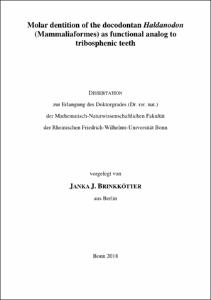Brinkkötter, Janka J.: Molar dentition of the docodontan Haldanodon (Mammaliaformes) as functional analog to tribosphenic teeth. - Bonn, 2019. - Dissertation, Rheinische Friedrich-Wilhelms-Universität Bonn.
Online-Ausgabe in bonndoc: https://nbn-resolving.org/urn:nbn:de:hbz:5n-54872
Online-Ausgabe in bonndoc: https://nbn-resolving.org/urn:nbn:de:hbz:5n-54872
@phdthesis{handle:20.500.11811/7941,
urn: https://nbn-resolving.org/urn:nbn:de:hbz:5n-54872,
author = {{Janka J. Brinkkötter}},
title = {Molar dentition of the docodontan Haldanodon (Mammaliaformes) as functional analog to tribosphenic teeth},
school = {Rheinische Friedrich-Wilhelms-Universität Bonn},
year = 2019,
month = jun,
note = {All extant mammals save the monotremes descend from an ancestor with tribosphenic tooth morphology, characterized by a distally situated crushing basin (talonid basin) on the lower and an interlocking cusp (protocone) on the upper molar. The development of this tooth morphology is regarded as a key innovation that allowed a very efficient processing of food by crushing and grinding during mastication. The first fully tribosphenic taxon is known from the Late Jurassic. However, the first taxon in mammalian history to develop a very similar tooth morphology with a mesially situated crushing basin on the lower and an interlocking cusp on the upper molar were the mammaliaform docodonts (Middle Jurassic to Early Cretaceous). To examine whether their "pseudotribosphenic" molar morphology is actually similar to the tribosphenic one, several upper and lower molar rows as well as numerous isolated molars of the Late Jurassic docodont Haldanodon exspectatus from the Guimarota coal mine (Leiria, Portugal) were studied in detail.
To quantify the amount of time spend on different mastication functions, a virtual simulation of the chewing stroke of Haldanodon was created with the open source software Occlusal Fingerprint Analyser (OFA), using 3D-models of un upper and two lower molars compiled from μ-CT scans. To determine the orientation of the movement of the lower molars during the chewing stroke for the OFA simulation, striation patterns were studied on SEM images of a few selected isolated molars.
The virtual reconstruction of the mastication cycle shows that the power stroke of Haldanodon has two phases. Phase 1 is a steep upward motion from buccal to lingual of the lower molars into centric occlusion where the upper molar occludes in between two lower molars. The second phase is either a downward palinal motion following centric occlusion (phase 2) or a separate upward proal motion (phase 1b). A comparison of molar functions of Haldanodon with the tribosphenic taxa Didelphis and Monodelphis shows that grinding is more distinct in both taxa. However, crushing in Haldanodon was at least equally distinct as in Monodelphis. In other docodont taxa with better enclosed "pseudotalonid" and "pseudotrigon basins" and additional distal basins on the lower molars crushing certainly was more distinct than in Monodelphis and maybe even equally distinct as in Didelphis. Although docodont molars were functionally similar to early tribosphenic molars their thin enamel layer made them much more prone to abrasion and the concomitant loss of function.},
url = {https://hdl.handle.net/20.500.11811/7941}
}
urn: https://nbn-resolving.org/urn:nbn:de:hbz:5n-54872,
author = {{Janka J. Brinkkötter}},
title = {Molar dentition of the docodontan Haldanodon (Mammaliaformes) as functional analog to tribosphenic teeth},
school = {Rheinische Friedrich-Wilhelms-Universität Bonn},
year = 2019,
month = jun,
note = {All extant mammals save the monotremes descend from an ancestor with tribosphenic tooth morphology, characterized by a distally situated crushing basin (talonid basin) on the lower and an interlocking cusp (protocone) on the upper molar. The development of this tooth morphology is regarded as a key innovation that allowed a very efficient processing of food by crushing and grinding during mastication. The first fully tribosphenic taxon is known from the Late Jurassic. However, the first taxon in mammalian history to develop a very similar tooth morphology with a mesially situated crushing basin on the lower and an interlocking cusp on the upper molar were the mammaliaform docodonts (Middle Jurassic to Early Cretaceous). To examine whether their "pseudotribosphenic" molar morphology is actually similar to the tribosphenic one, several upper and lower molar rows as well as numerous isolated molars of the Late Jurassic docodont Haldanodon exspectatus from the Guimarota coal mine (Leiria, Portugal) were studied in detail.
To quantify the amount of time spend on different mastication functions, a virtual simulation of the chewing stroke of Haldanodon was created with the open source software Occlusal Fingerprint Analyser (OFA), using 3D-models of un upper and two lower molars compiled from μ-CT scans. To determine the orientation of the movement of the lower molars during the chewing stroke for the OFA simulation, striation patterns were studied on SEM images of a few selected isolated molars.
The virtual reconstruction of the mastication cycle shows that the power stroke of Haldanodon has two phases. Phase 1 is a steep upward motion from buccal to lingual of the lower molars into centric occlusion where the upper molar occludes in between two lower molars. The second phase is either a downward palinal motion following centric occlusion (phase 2) or a separate upward proal motion (phase 1b). A comparison of molar functions of Haldanodon with the tribosphenic taxa Didelphis and Monodelphis shows that grinding is more distinct in both taxa. However, crushing in Haldanodon was at least equally distinct as in Monodelphis. In other docodont taxa with better enclosed "pseudotalonid" and "pseudotrigon basins" and additional distal basins on the lower molars crushing certainly was more distinct than in Monodelphis and maybe even equally distinct as in Didelphis. Although docodont molars were functionally similar to early tribosphenic molars their thin enamel layer made them much more prone to abrasion and the concomitant loss of function.},
url = {https://hdl.handle.net/20.500.11811/7941}
}






